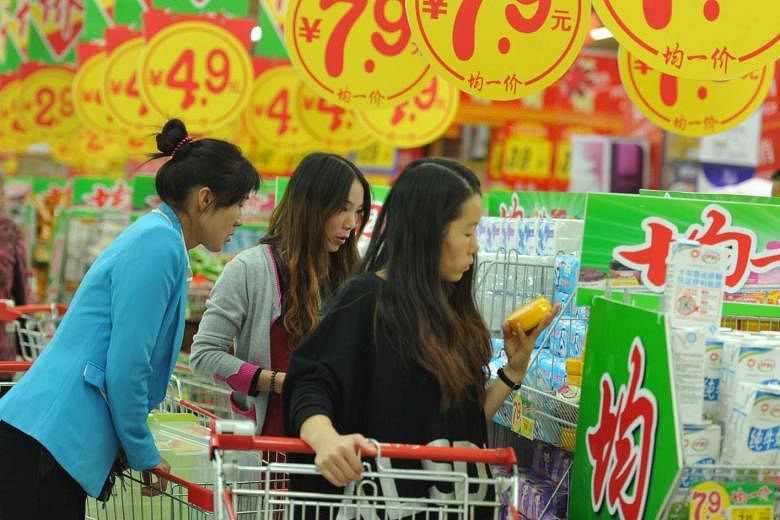BEIJING (BLOOMBERG) - China's leaders are poised to lower their growth target for the next five years as they wrestle with challenges from rising debt to excess industrial capacity and bloated state enterprises.
More than two-thirds of 16 economists surveyed by Bloomberg News expect the growth target to be set at an annual average pace of 6.5 per cent or less for 2016 to 2020, down from 7 per cent the previous five years.
A quarter of the economists said growth will slip below 4 per cent year-on-year at some point during the next five years - perhaps not a hard landing, but a hard bump for an economy that has averaged about 10 percent growth over the past three decades.
The 13th five-year plan is poised to be the first since Deng Xiaoping opened the nation to the outside world in the late 1970s to confront an era of sub-7 per cent annual growth. The deliberations of the plan will be announced after the October gathering in Beijing known as a plenum. It will then be formally approved by lawmakers at an annual parliamentary session in March.
At stake for President Xi Jinping and Premier Li Keqiang is whether China can shift from a middle-income to high-income nation, a feat Nobel laureate Michael Spence says has been realized by only five economies - Japan, South Korea, Taiwan, Hong Kong and Singapore - while maintaining relatively high growth rates. Crafting of the five-year plan coincides with heightened anxiety over China's economic outlook following a stock market slump and surprise yuan devaluation in August that roiled global markets.
"This five-year plan and its outcomes will define whether the leadership of Xi and Li will be associated with economic success or stagnation," said James Laurenceson, deputy director of the Australia-China Relations Institute at the University of Technology in Sydney. "Themes such as promoting domestic consumption and industrial upgrading were included in the previous five-year plans but now they're imperatives, not worthy aspirations."
Growth this year is on pace for the slowest expansion in a quarter of a century as exports falter and investment spending growth slows. The third-quarter expansion slipped to 6.8 per cent from a year earlier, according to economists surveyed by Bloomberg News. ahead of data due Monday.
A boom in the equity markets added an estimated 0.5 percentage point to growth in the first half, according to Bloomberg Intelligence economists. That has now "turned to bust," suggesting the financial sector's contribution to GDP in the third quarter will be smaller, Tom Orlik and Fielding Chen wrote in a note.
Mr Xi and Mr Li face constraints including an aging population and shrinking workforce, vested interests opposed to market- driven change, and anemic demand from abroad for the nation's exports. Success will require a shift to more innovative, higher-valued industries requiring greater creativity, allowing state enterprises to fail, and building a financial system that directs capital more to vibrant private companies than deadbeat state ones.
"The five-year plan likely will contain a lot of wording about turning China into a high-tech, innovative economy," said Victor Shih, a professor at the University of California at San Diego who studies China's politics and finance.
"However, the central issue facing the economy continues to be whether bloated state enterprises and local government financing vehicles will be allowed to go bankrupt and whether state enterprises will continue to receive preferential treatment from the government and from the banks. Unless these key issues are addressed, China will continue to fall toward a middle-income trap."
Mr Xi and Mr Li need to maintain growth of about 6.5 per cent annually in order to meet a goal of doubling gross domestic product and personal income by 2020 from 2010, said Zhao Yang, chief China economist at Nomura Holdings in Hong Kong.
Rhe main challenge is how to achieve that rate of growth while also restructuring the economy and avoiding a crash, said Shen Jianguang, chief Asia economist at Mizuho Securities Asia Ltd. in Hong Kong.
A person familiar with preparatory talks on the plan said earlier this year that the party may opt for a target range for growth of 6.5 per cent to 7 per cent, and make that a flexible guideline. Also under consideration: shifting the priority to population policies, amid projections of a demographic slide.
"The fact that policy makers perceive that they still have room to use macro policy to shore up growth makes a hard landing pretty unlikely in the coming two years," said Louis Kuijs, head of Asia economics at Oxford Economics Ltd. in Hong Kong. "With a national savings rate of 50 per cent and sufficient macro policy space left, the government can achieve its growth targets if it really wants to."

